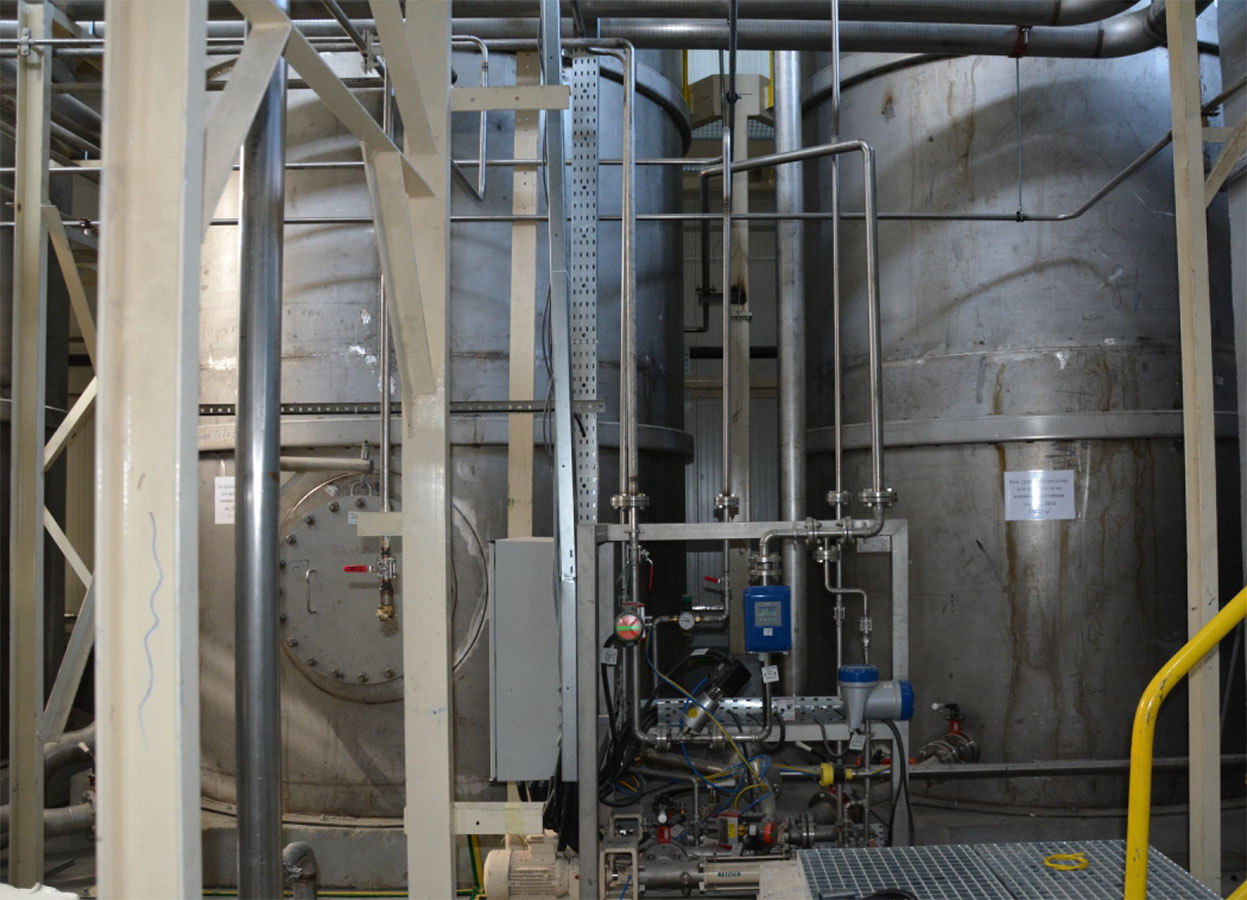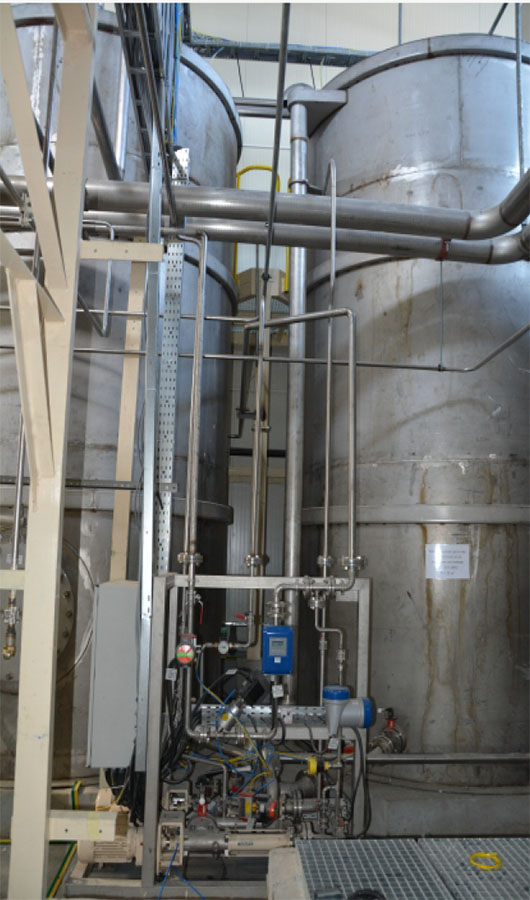WSR DSR Agents Storing And Dosing Equipment
WSRs (wet strength resins) increase wet paper strength parameters. The equipment is available for capacities 1 – 100 tph. The resin storage concept depends on the paper machine output.
For PMs of capacities up to 20 tph the WSRs are usually purchased in 1 000 kg IBC containers, for higher demands the 15 – 23 t road tank deliveries are advantageous. If the IBC containers are used the “mother-daughter“ configuration of two vertically positioned IBCs (one above another) can be possibly utilised. The bottom work container volume is 1 200 litres to contain the entire volume of the top standard 1 000 kg IBC. Both containers are placed in a steel frame. The top container from where the WSR flows to the bottom work container by gravity is put into the frame by means of crane or forklift. The bottom work container is equipped with a limit level sensor or an analogue 4 to 20 mA level sensor providing the PM control system with the container level status signal.
If the high WSR consumption does not allow utilising IBC containers PAPCEL offers to build a system of one or more storage tanks. Their volume is designed with regards to the product logistics; usually it is 25 to 30 m3 so that each tank containes an entire delivery volume with a sufficient reserve. The system is usually advantageously designed to enable pumping each delivery out into a storage tank cleaned beforehand meanwhile the other tank serves as a source. Thus, two or three tanks of sufficient capacities simply alternate and their quality hygiene is enabled, above all wherever ambient temperatures are high.
The storage systems include automatic tap off systems with assigned fittings; the operator chooses the pipeline route and the tank from the board in the control room and the systems arrange correct taping delivery off to the respective tank. The WSR storage system is usually designed to work in a fully automatic mode, therefore the tanks and fittings are equipped with usual level sensors and sensor of particular fitting state.
The dosing station design depends on a particular case. The dosing pump works separately, for high-performance PMs spare pumps are installed automatically or manually switched on if the working pumps fail. The dosing stations cover throughput quantities of 10 to 1 500 lph but stronger pumps are designed if necessary. The pump type depends on the performance; electric diaphragm pumps (throughput up to 375 lph) or screw (Mohno) pumps (throughput up to thousands lph) are used. The station is usually designed as a separate unit installed in a support frame. The frame is anchored to the assigned position by means of chemical anchors and it is connected to media inlet/outlet pipelines, to signal and power cables.
Before entering the dosing point the product may be continuously diluted in a ratio mode with fresh water or pure filtrate. The dilution is fully automated and it is switched on together with switching the pump on. The dilution water delivery is controlled by means of manual valve in a constant ratio or by means of automatic control circuit controlling the dilution water throughput in an exact ratio to WSR.
Material
- Plastics (PP, PE) or AISI 316 grade stainless steel
The tanks are either delivered ready-made (standing on legs to be anchored to a concrete foundation by means of anchor bolts) or are welded on-site – in such case the tank bottoms are grouted with concrete.
DSR (dry strength resin) storing and dosing system
DSRs (dry strength resins) increase wet paper strength parameters.
PAPCEL offers various systems for preparing and dosing of DSR systems, e.g. guar solutions or carboxyl-methyl-cellulose (CMC).
The systems cover a wide paper machine output range from 1 to 50 tph. Generally, the equipment prepares solutions of concentrations from powder products given beforehand and the solutions are dosed to paper machine systems in precise throughput volumes.
The powder products are purchased either in 20 to 50 kg sacks or 650 to 1000 kg “BigBags”. The plant consists of a hopper able to contain hundred kgs of product (depending on specific weight) – then either a 430 litre standard hopper or a 1 to 10 m3 silo is used for higher demands.
Alternatively other silos may be used if the product is delivered in road tankers (then the systems are similar to those used for storing and dosing starch).
The equipment for “Big-Bag” packaging is either delivered with a lifting tower or an existing proper lifting equipment is utilised. The powder material is furnished into the hopper and from there transported into a dissolving tank by means of worm conveyor in a defined mode.
The conveyor drive is controlled by means of frequency converter to achieve a high dosing accuracy. The quantity of the product furnished into the tank is measured by means of strain gauge installed in the dissolving tank legs.
The covered tank contains a high performance dispersing agitator of performance designed with regards to the dissolved material, its final concentration and viscosity. The agitator work element is a Z-disc. The agitator is driven either directly or by means of belt gear. The agitator motor is controlled by means of frequency converter increasing the system variability with regards to the operating conditions.
The dissolving tank components are water measuring system, a high-pressure wall and an agitator shower system, a material furnish air filtration and measuring & control (M&C) elements (such as level and temperature sensors, viscosity measuring and control system is delivered on demand). The solution is pumped either by a diaphragm pump driven by pressure air (of a high capacity and a long lifespan) or by a screw (Mohno) pump (with or without a performance control) or by a centrifugal pump. The solution is pumped into a storage tank of volume designed from the given conditions. The storage tanks volumes are in a very wide range from 3 to 100 m3. They are equipped with agitators to achieve homogeneity of the solutions or slurries, with level sensors and emergency limit level sensors.
The design of the dosing stations depends on the required capacity in the range of tens up to thousands of litres per hour. The pumps are either an electrically driven diaphragm type or a screw type, always controlled by means of frequency converters.
The solution throughput is measured by means of inductive flowmeter or mass flowmeter for higher demands. The dosing station is designed with regards to the performance and it contains either one or more pumps with needed fittings and M&C elements.
Usually it is designed as a compact unit connected to the inlet and outlet pipelines by means of standard flanges. The connection to the power and signal cabling systems is designed with regards to the conditions on site. Concentrator boxes as well as switchboards can be used or the M&C elements are connected directly to the mill control system in the main electric distribution cabinet.
Material
- Plastics (PP, PE) or AISI 304/316 grade stainless steel depending on the used product
The tanks are either delivered ready-made (standing on legs to be anchored to a concrete foundation by means of anchor bolts) or are welded on-site – in such case the tank bottoms are grouted with concrete.
The machinery design and safety comply with the EU and EAC industrial standards.
-
Category
Cultural / Industrial Length
4 feetWidth
6 feetHeight
10 feetWeight
580 kgSpace Require
14 sq. feet

Company Presentation
[elementor-template id="3268"]

